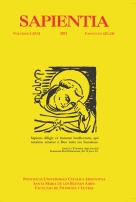Por favor, use este identificador para citar o enlazar este ítem:
https://repositorio.uca.edu.ar/handle/123456789/4638| Campo DC | Valor | Lengua/Idioma |
|---|---|---|
| dc.contributor.author | Carreño Pavez, Juan Eduardo | es |
| dc.contributor.author | Serani Merlo, Alejandro | es |
| dc.date.accessioned | 2019-06-01T18:44:35Z | - |
| dc.date.available | 2019-06-01T18:44:35Z | - |
| dc.date.issued | 2011 | - |
| dc.identifier.citation | Carreño Pavez, J. E., Serani Merlo, A. La Teoría del diseño inteligente : un análisis desde el tomismo [en línea]. Sapientia. 2011, 67 (229-230). Disponible en: https://repositorio.uca.edu.ar/handle/123456789/4638 | es |
| dc.identifier.issn | 0036-4703 | - |
| dc.identifier.uri | https://repositorio.uca.edu.ar/handle/123456789/4638 | - |
| dc.description.abstract | Resumen: Michael Behe y William Dembski son dos de los líderes de la Teoría del Diseño Inteligente, una propuesta surgida como respuesta a los modelos evolucionistas y anti-finalistas prevalentes en ciertos ambientes académicos e intelectuales, especialmente del mundo anglosajón. Las especulaciones de Behe descansan en el concepto de “sistema de complejidad irreductible”, entendido como un conjunto ordenado de partes cuya funcionalidad depende estrictamente de su indemnidad estructural, y que su origen resulta, por tanto, refractario a explicaciones gradualistas. Estos sistemas, según Behe, están presentes en los vivientes, lo que permitiría inferir que ellos no son el producto de mecanismos ciegos y azarosos, sino el resultado de un diseño. Dembski, por su parte, ha abordado el problema desde una perspectiva más cuantitativa, desarrollando un algoritmo probabilístico conocido como “filtro explicatorio”, que permitiría, según el autor, inferir científicamente la presencia de un diseño, tanto en entidades artificiales como naturales. Trascendiendo las descalificaciones del neodarwinismo, examinamos la propuesta de estos autores desde los fundamentos filosóficos de la escuela tomista. A nuestro parecer, hay en el trabajo de estos autores algunas intuiciones valiosas, las que sin embargo suelen pasar desapercibidas por la escasa formalidad en que vienen presentadas, y por la aproximación eminentemente mecanicista y artefactual con que ambos enfrentan la cuestión. Es precisamente a la explicitación de tales intuiciones a las que se dirige el artículo. | es |
| dc.description.abstract | Abstract: Michael Behe and William Dembski are two leaders of the Intelligent Design Theory, a proposal that emerges in response to anti-evolutionary and anti-finalistic models prevalent in certain academic and intellectual environments of the Anglo Saxon world. Behe speculation rests on the concept of “irreducible complex system”, understood as an ordered set of parts whose functionality is strictly dependent on its structural indemnity, and its origin is therefore refractory to gradualist explanations. These systems, according to Behe, are present in living beings, allowing the inference that they are not the product of blind and random mechanisms, but the result of a design. Dembski, meanwhile, has addressed the problem from a quantitative perspective, developing a probabilistic algorithm known as “the explanatory filter”; according to the author, this filter allows to scientifically infer the presence of a design, both in artificial and natural entities. Beyond the neo- Darwinist criticism, we examine the proposal of these authors from the philosophical foundations of the Thomistic school. In our view, there are some valuable intuitions in the work of Behe and Dembski, yet often go unrecognized by the lack of formality in which they come forward, and the artefactual and mechanistic approach that both authors exhibit. This article focuses precisely on the explicitation of such intuitions. | es |
| dc.format | application/pdf | es |
| dc.language.iso | spa | es |
| dc.publisher | Universidad Católica Argentina. Facultad de Filosofía y Letras | es |
| dc.rights | Acceso Abierto | es |
| dc.rights.uri | https://creativecommons.org/licenses/by-nc-sa/4.0/ | es |
| dc.source | Sapientia. 2011, 67 (229-230) | es |
| dc.subject | Tomás de Aquino, Santo, 1225?-1274 | es |
| dc.subject | Behe, Michael | es |
| dc.subject | Demsbki, William | es |
| dc.subject | TOMISMO | es |
| dc.subject | TEORIA DEL DISEÑO INTELIGENTE | es |
| dc.title | La Teoría del Diseño Inteligente : un análisis desde el tomismo | es |
| dc.type | Artículo | es |
| uca.path | Sapientia|2011 Vol LXVII nº 229-230 | es |
| uca.disciplina | FILOSOFIA | es |
| uca.filename | /home/data-uca-generic/folder_generic/sapientia229-230/teoria-diseno-inteligente-analisis-tomismo/metadata.xml | es |
| uca.issnrd | 1 | es |
| uca.affiliation | Fil: Carreño Pavez, Juan Eduardo. Universidad de los Andes; Chile | es |
| uca.affiliation | Fil: Serani Merlo, Alejandro. Universidad de los Andes; Chile | es |
| uca.orden | 07 | es |
| uca.version | publishedVersion | es |
| item.grantfulltext | open | - |
| item.fulltext | With Fulltext | - |
| item.languageiso639-1 | es | - |
| Aparece en las colecciones: | SAP - 2011 Vol LXVII nro. 229-230 | |
Ficheros en este ítem:
| Fichero | Descripción | Tamaño | Formato | |
|---|---|---|---|---|
| teoria-diseno-inteligente-analisis-tomismo.pdf | 232,59 kB | Adobe PDF |  Visualizar/Abrir |
Visualizaciones de página(s)
4.132
comprobado en 30-abr-2024
Descarga(s)
2.038
comprobado en 30-abr-2024
Google ScholarTM
Ver en Google Scholar
Este ítem está sujeto a una Licencia Creative Commons

